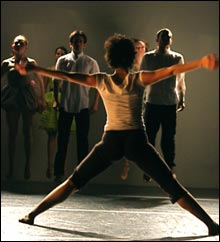
I CAN SEE MYSELF IN YOUR PUPIL: Andrea Miller has the gift of structure as well as expressive movement. |
NEW YORK — Gotham was awash in dance during early January as the annual Dance on Camera Festival coincided with the conference of the Association of Performing Arts Presenters (better known as APAP, the national bookers' convention). Screenings, showcases, and studio performances by local and visiting dance groups took place all over the city. Besides all that, New York City Ballet swung into its eight-week post-Nutcracker winter season.You could watch dance 12 hours a day and still not see half of the possibilities. I staggered home with a load of press kits and more dance images in my head than I'll ever be able to process. Here are a few impressions.
After Chaconne and The Four Temperaments on an all-Balanchine evening at City Ballet, I felt I'd seen enough wonderful dancing and choreography to sustain me quite a while. Vienna Waltzes, which ended the program, seemed very long and almost monotonous. Balanchine was a master of thematic variation — see the gigantic Union Jack, or even Chaconne and Four T's. His extended meditation on the 19th-century waltz now seems less haunted, less textured, than I remember it. The dancers performed as if the ballet were only about steps and sumptuous costumes.
At Dance on Camera, at the Walter Reade Theater in Lincoln Center, I saw a new documentary about the celebrated flamenco dancer Antonio Gades, The Ethics of Dancing, directed by Juan Caño Arecha. Gades's dramatic dancing is preserved in his three film collaborations with director Carlos Saura, Blood Wedding, Carmen, and El Amor Brujo (released as an Eclipse Series package), but Arecha's documentary gives us only glimpses of his concert and theater work. Most of the dance footage, including snippets of a lost ballet he did in Cuba with Alicia Alonso, is overlaid with appreciative but distracting talk in Spanish, and lengthy subtitles thereof.
An evening of works from Japan, Taiwan, and Korea at the Japan Society was accompanied by some excruciatingly loud music. People in New York bring their own earplugs to these events, but I was dazed. At Dance Theater Workshop, D.D. Dorvillier and Zeena Parkins collaborated on Choreography, a Prologue for the Apocalypse of Understanding, Get Ready!, a series of experiments in translating simple movement into sound.
At the Baryshnikov Arts Center, Jane Comfort showed a brainy, funny, scary excerpt from her 2008 work An American Rendition. Comfort mentored three other women choreographers for this third series in the residency project Sugar Salon.
Douglas Dunn is reviving his 1980 company dance Pulcinella next month. He showed some excerpts from this and a new piece in his studio, reminding me how subtle his work is. Dunn is a complete original, and at 66 he's still performing, as lecherous danseur, beast, and majordomo in his beautiful, screwball dances.
The most interesting of the younger choreographers I saw, Andrea Miller, was doing two weeks at the Joyce SoHo with her Gallim Dance company. I Can See Myself in Your Pupil, the older of the two works in the repertory, was an explosively physical piece for eight dancers, the kind of thing that bursts out of artists sometimes as they embark on their choreographic adventures. Later, looking at a DVD of the piece provided by the company, I realized Miller has the gift of structure as well as expressive movement.